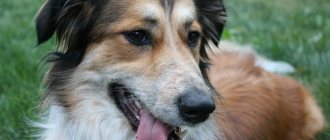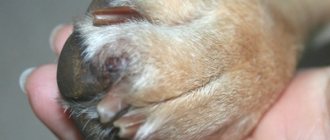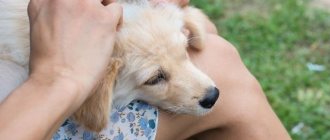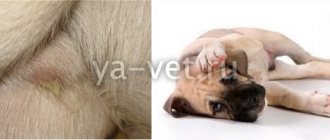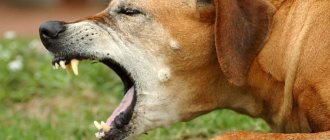Mostly, calluses develop in the elbow and hock joints (back legs). These calluses are dry, scaly, hairless and hard. Some are dark brown and black, and some are grey; it depends on the dog's skin and how long he has had the callus. Just like in humans, dog calluses are caused by the skin being in contact with something hard for an extended period of time, over time it becomes rough, cracked and sometimes requires veterinary attention. What are calluses on the elbows in dogs and what treatment is applicable to them can be read below.
Causes of calluses
A callus is a limited area of skin that appears above the area of bone compression. Hardening of the skin (hyperkeratosis) of the damaged area develops as a result of constant friction in the same place. In this case, necrosis of the skin occurs and the upper layers of the epidermis are layered on it. Appearance – dense dry growth, with rounded edges, usually oval in shape.
The most common places where calluses appear in an animal are:
- elbows;
- hock joints;
- sternum;
- calluses on the fingertips.
Growths appear on the elbow bends of the paws and in the joint area due to the dog’s habit of lying on a hard surface - wooden or concrete decks and floors, stone paths and porches. They become additional protection for the elbow tendons. In winter, they appear extremely rarely, since in the cold season pets often prefer warm and soft bedding for sleep. In small dogs, calluses appear from rubbing their chests on stairs (common in dachshunds and basset hounds). If the animal is overweight and walks for a long time every day, they form on the pads of the paws.
Popular symptoms
There are some common symptoms that will indicate a skin condition in a dog.
Red spots on a dog's belly
Red spots on the belly of dogs can be found very often. They are especially noticeable in the belly and groin area, since the fur there is not so thick. They can often be observed in allergic conditions as a response of the skin to the entry of an allergen into the body. We will talk about different types of allergies in more detail below. Red, ring-shaped spots on a dog's body will indicate bites from parasites such as mosquitoes and midges, which especially prefer hairless areas of the skin.
Skin ulcers in dogs
An ulcer is a deep inflammatory lesion of tissues with a violation of their integrity; the ulcer heals mainly with the formation of a scar. Sores on the stomach, back and other parts of the dog’s body, similar to ulcers, will most likely indicate a deep infection of the skin. Ulcers are also possible due to chemical burns, impaired blood supply or nerve conduction in the area. Malignant tumors can often look like ulcers.
Irritation in your dog's stomach or groin
By irritation we mean the presence of papules (pimples) and pustules (pustules) on the skin. Most often, the appearance of acne on a dog's body is a sign of superficial bacterial inflammation of the skin. But this can also happen with a parasitic disease, an autoimmune process. In atypical cases, even lichen may look similar. Diaper rash can appear in overweight dogs with a large number of folds (Shar Pei, bulldogs) due to infection multiplying in the skin folds. Sometimes the only treatment is plastic surgery.
The dog has a white coating on his nose
The change in color of the nose to white can be due to several reasons.
- "Winter Nose"
Some dog breeds are prone to lightening of the nose in the winter, these include Labrador, Husky, Golden Retriever, Shepherd, Bernese Mountain Dog and some others. This condition is popularly called “winter nose”, and it is associated with a reduction in daylight hours and a limitation in the production of melanin by the skin. In the summer, the nose of these dogs returns to its normal color.
- Vitiligo
Vitiligo is a disease of the immune system in which pigment cells stop producing pigment cells in some areas of the body. This condition is irreversible, but does not require treatment, since it does not harm the body.
- Lupus
An autoimmune disease such as discoid lupus erythematosus may cause a change in nose color. If your dog has lupus, you can expect other symptoms on the skin, crusting of the nose, scrotum, and pads. This condition requires serious treatment.
- Uveodermatologic syndrome
This condition is also associated with the dog's immune system and occurs due to the destruction of pigment cells in the skin by immune cells. The dog has a whitening of the nose, skin and fur around the eyes, lips, and then other parts of the body. This is accompanied by eye damage with inflammation of the choroid.
Your dog's skin is peeling and hair is falling out
Hair loss, which is accompanied by flaking, is often a sign of dermatophytosis (lichen). Typically, the lesions are localized at the onset of the disease, but without treatment they begin to spread throughout the body. We will discuss this disease in more detail below. Also, hair loss with peeling is characteristic of various endocrine diseases, while bald patches will most often be located symmetrically across the body. In dogs with plush fur, such as Spitz, Chow Chow, Husky, if hair loss occurs, Alopecia X should be suspected.
Breeds at risk for developing calluses
All breeds are prone to developing calluses. They most often appear in male dogs, whose skin is less elastic than that of female dogs. At risk are dogs with short hair and no undercoat, large breeds and/or overweight dogs. Calluses occur when an animal’s diet lacks vitamins A, C, E, microelements, collagen and a uniform nutritional system.
Shepherd breeds prone to calluses include:
- German;
- Central Asian;
- Eastern European.
The list is completed by Labradors, which despite their playful nature love to eat, are often overweight. This breed has a genetic predisposition to joint diseases and calluses.
Fungal skin diseases in dogs
Dermatophytosis
Dermatophytosis, or simply lichen, is a fungal skin disease of dogs. Common in street dogs but not highly contagious. Infection will depend on the immunity of each individual animal. There are four main causative agents of lichen in dogs: Microsporum canis, Microsporum gypseum, Trichophyton mentagrophytes, Microsporum persicolor. The diagnosis is made using fluorescent diagnostics, trichoscopy, PCR testing and culture.
Symptoms
Most often, with lichen, there will be patches of bald patches with peeling. Localization may vary; Once on some part of the body, the fungus spreads further along the skin, and as a result, the dog can become completely bald. There is an atypical form of lichen in dogs - kerion. Kerion looks like a round, pink plaque raised above the surface of the skin. It is often located on the dog's nose and can be mistakenly called a pimple. There is no itching in the initial stages. After some time, secondary bacterial flora joins the fungi, the lesions may become red, with a large number of pimples, and the dog will begin to scratch itself.
Treatment
Most often, local and systemic treatment is used simultaneously. Local preparations include solutions of hydrogen sulfide and enilconazole. Of the systemic drugs, the choice falls on itraconazole, ketoconazole, terbinafine. The premises must also be treated to eliminate the spread of spores in the environment. Products in the form of smoke bombs with an antifungal active ingredient are well suited. Smoke settles in all the smallest crevices, which improves the quality of cleaning.
Malassezia dermatitis
Malassezia dermatitis is caused by the yeast fungus Malassezia spp growing on a dog's skin. Most often, this is a secondary disease that occurs against the background of allergies, endocrine diseases, demodicosis, and seborrhea. Malassezia dermatitis very often accompanies atopic dermatitis. Normally, all healthy dogs have these fungi in single quantities. But under favorable conditions, they multiply and cause certain symptoms. The diagnosis is made by performing a cytological examination of skin lesions.
Symptoms
In most cases, Malassezia dermatitis will be itchy and your dog will scratch and lick the affected area. A rash in a dog due to fungal dermatitis is rare, unlike bacterial dermatitis. The characteristic signs of this particular disease are a change in the color of the skin and coat to rusty, thickening of the skin, as well as a specific sweetish odor.
Treatment
First of all, it is necessary to establish the disease against which Malassezia dermatitis developed and take it under control. To treat fungal overgrowth, local medications are used, most often in the format of shampoos. A solution of 3% vinegar can be used. If the damage is significant, systemic antifungal drugs are added.
The danger of calluses for an animal
Many owners do not consult a doctor when they discover calluses, considering them a problem only from a cosmetic point of view. But calluses must be treated. When walking, they can cause pain and discomfort to the animal. The dog often licks wounds on the elbow joints and there is a risk of pathogenic bacteria and organisms getting into it, which will lead to inflammation and the development of callus dermatitis. In addition to rough, gray skin, if untreated, ulcers appear, accompanied by itching and pain.
Bacterial skin diseases in dogs
Superficial pyoderma
Superficial pyoderma in most cases is not a disease itself, but only a manifestation of some other underlying cause. Most often, the primary disease in dogs with pyoderma will be allergies, endocrinopathies, and minor injuries. The main causative agent of pyoderma is staphylococcus (Staphylococcus pseudintermedius); small amounts of this bacterium can be found even on normal skin. Under favorable conditions, staphylococcus begins to multiply and cause changes in the skin. The diagnosis is made based on characteristic clinical signs and the results of cytological examination of the affected areas.
Symptoms
With superficial pyoderma, dogs often have pimples on the body, pustules, hairless areas of skin, crusts, scales, and changes in skin color. Lesions that look like heat rash in a dog will also indicate a bacterial infection in most cases. Often the dog will experience severe itching and scratch itself, causing damage and making the situation even worse.
Treatment
To treat pyoderma, it is first necessary to discover the cause that caused it. To cope with bacterial overgrowth, antibacterial drugs are used. First of all, local products with chlorhexidine and benzoyl peroxide, such as shampoos, gels, and solutions, are prescribed. If the lesions are extensive, long-term systemic antibiotic therapy may be prescribed.
Deep pyoderma
Deep pyoderma is also a secondary disease, but is characterized by damage to the deeper layers of the skin. Here, the root cause can often be a dog affected by demodicosis, since this mite multiplies in the hair follicles. Also, the deep layers are involved in the process if the treatment of superficial pyoderma was not started on time. Chemical, thermal burns and other injuries contribute to deep skin infection.
Symptoms
The lesions will be more pronounced than with a superficial infection. In addition to the typical rash on the dog’s stomach, one can note the appearance of boils, ulcerations, and fistula openings with discharge.
Treatment
Treatment usually combines the use of local agents and systemic drugs. Shampoos, solutions, gels are used. Antibiotics are prescribed from systemic drugs based on the results of a culture test. Antibiotics should be taken in dermatological, that is, in higher dosages, usually for a course of at least 4 weeks and another 2 weeks after complete recovery. Anti-itch and anti-inflammatory drugs may be used.
Treatment of calluses
Calluses are sometimes confused with symptoms of a serious illness, so contact your veterinarian first if you notice a lump. After a visual examination, the doctor will prescribe a cytological or biopsy examination, and if there is discharge from the wound (exudate), an analysis of its composition.
Once diagnosed, the recovery plan includes the following steps:
- Treat with antiseptic drugs to prevent infection (Chlorhexidine, Miramistin, Octenisept, hydrogen peroxide).
- At the beginning of the appearance of calluses, apply dermatoprotective ointments Radevit or Videstim to the skin. The procedure of rubbing vegetable oil (olive, peach, flax or sunflower) into the skin at least 2-3 times a day showed a good therapeutic effect. To preserve furniture, carpets and floor coverings, the treated area must be covered with a bandage.
- If there is no discharge in the form of ichor, pus or clear mucus, apply nourishing wound healing agents Bepanten, Depanthenol, and Bübchen brand baby cream.
- Treat dry calluses using traditional methods.
- If there is discharge, open wounds or sores, use antibacterial anti-inflammatory drugs - Dimexide, Levomekol, Malavit. In case of severe disease and infection, use Clotrimazole or Triderm. Use only as prescribed by a doctor.
In parallel with local treatment, a course of injections or tablets is sometimes prescribed, including to enhance immunity. If there are ingrown hairs in the callus, the doctor removes them in the hospital to avoid recurrent infection. Surgical intervention, as a rule, does not occur, since it is complicated by the divergence of the wound edges. If the callus is not infected, it does not affect the dog's quality of life.
Skin diseases in dogs caused by parasites
Demodicosis
Demodicosis is a disease caused by the skin parasite Demodex canis. It is a mistake to call Demodex a subcutaneous parasite, since this mite lives in the hair follicles of the skin of dogs, and not under the skin. Normally, this mite is found in single quantities on the skin of all dogs, but it begins to multiply intensively and cause disease only under favorable conditions, most often against the background of a decrease in the body’s general immunity. The diagnosis is confirmed by deep scrapings from all lesions.
Symptoms
The main symptoms are patchy hair loss and flaking. You can often find hair loss around the eyes, the so-called “glasses”. Blackheads on the body (comedones) are clearly visible on hairless areas of the body. At the initial stage, the dog will not itch, but without treatment, a secondary infection will join demodicosis, and it will already cause itching. Then you will notice the appearance of pimples, pustules, scratching, redness of the skin, and the dog will behave restlessly.
Treatment
In mild cases, treatment for demodicosis is not required, since it can go away on its own when the immune system is restored. In the generalized form, treatment is required. Recently, modern drugs from the isoxazoline group have been used; even a single dose can defeat this disease. Sometimes taking medications for a longer period of time is required, as well as additional use of antibacterial agents locally or systemically. All dogs that have ever suffered from generalized demodicosis should be removed from breeding, as there is a high probability of transmitting this disease to offspring.
Sarcoptic mange
Sarcoptic mange in dogs is caused by the scabies mite Sarcoptes scabiei. It is highly contagious between dogs and is widespread among street dogs. The diagnosis is often made only on the basis of clinical signs, since detection of a mite in a scraping is not very likely. Successful treatment can also confirm the diagnosis.
Symptoms
The favorite breeding places for this tick on a dog are the ear and muzzle areas. The skin in these places becomes dark, dense, covered with crusts and scabs, and hair falls out. The dog experiences severe itching and scratches itself. Without treatment, the mite spreads to other parts of the body and can cover the entire skin of the animal.
Treatment
For treatment, the same means are used as in the fight against demodicosis. These include isoxazoline preparations, topical antibacterial agents, and exfoliating shampoos to remove crusts. Prevention means no contact with sick animals and regular treatments with anti-external parasite agents.
Hurry up, choose a box and find out what gift awaits you
Discount on pet insurance
Promo code copied to clipboard
Traditional medicine recipes
You don’t always need to buy expensive medicines; you can try one of the following traditional medicine recipes:
- Mix aloe juice, fish oil and vitamin E.
- Make a puree of raw potatoes with onions.
- Grate raw potatoes and add honey.
Mix all ingredients in equal proportions and apply to damaged skin throughout the day. It is useful to apply propolis heated in your hands to calluses. Coconut oil, currently popular in cosmetology, can also be rubbed in for 2-3 minutes to soften the callus and speed up the healing process.
How to stop bleeding
A dog may come running home bleeding profusely and scare its owners. Sometimes, if the bleeding is not stopped immediately, the animal dies from its loss.
In fact, there is nothing complicated about this technique. In case of a wound on the face or paws, a tight bandage is sufficient, because there are no large vessels in these areas.
But when the wound is dangerous and there is a lot of blood, immediately apply a tourniquet. Remember that in warm weather it is applied for 1-2 hours, in cold weather - 3 hours, no more.
Having stopped the bleeding, emergency care is already provided, starting with washing the injury and ending with a bandage.
Examination of the animal
Make it a rule to examine your animal once a week, paying attention to the elbows and joints. If compactions appear on them, determine the speed at which they appear and their size. If blood discharge or swelling appears on the skin, measure the temperature of the source of inflammation. Tactilely determine whether the formation is soft or hard.
A callus usually develops over a long period, and if thickening appears within 3-5 days, consult a doctor immediately to exclude the development of dangerous diseases. If there is any discharge on the damaged area of skin, contact your veterinarian, even if the animal does not show signs of concern. For preventative purposes, visit the clinic at least 2 times a year for a preventive examination to stop the process of calluses if it is detected.
What to do?
Of course, the right decision would be a visit to the veterinarian . Under no circumstances should you self-medicate or test various anti-inflammatory ointments and more serious medications on an animal. Also, during an independent examination, you should not destroy the surface of the callus, this can lead to a serious inflammatory process and also cause pain to your pet. The growths on the elbows should be examined exclusively by a qualified specialist who will be able to distinguish a callus from dermatitis, hygroma or some other more dangerous disease.
The only thing that is required of the owners is to adhere to the veterinarian’s recommendations, and also to provide the pet with a softer place to sleep, which will not injure existing growths from contact with the elbows.
Purulent wounds
If the wound occurred after surgery and after primary surgical treatment, it is considered clean.
But after injury with sharp, relatively clean objects over a short period of time, the wounds are usually considered infected. When the degree of bacterial contamination is high and a pronounced inflammatory process is observed, the wound begins to fester. Causes of purulent wounds:
- insufficient hygiene when dressing,
- lack of seam care,
- low dog immunity,
- unhealthy diet
- vitamin deficiency.
Symptoms and signs that indicate a purulent process:
- there is swelling around the wound,
- tissues near the wound become hot,
- the dog whines in pain when touched,
- the temperature rises,
- appetite decreases,
- general condition is depressed.
Closed wounds with deep damage and a narrow entrance hole are especially susceptible to suppuration. Because of this, air does not enter the wound, and suitable conditions are created for the proliferation of pathogens.
Treating a superficial wound
Before you start processing, you must thoroughly wash your hands and treat them with an antiseptic.
How to treat a superficial wound for a pet:
- clean the wound from foreign bodies using tweezers,
- moisten a cotton pad with chlorhexidine and rinse the wound from dirt with light movements,
- use scissors to remove hairs around the wound,
- stop bleeding with hydrogen peroxide,
- treat the edges of the wound with an antiseptic,
- apply a bandage to the wound. You need to press on the wound very carefully so as not to cause unnecessary pain to the dog.


